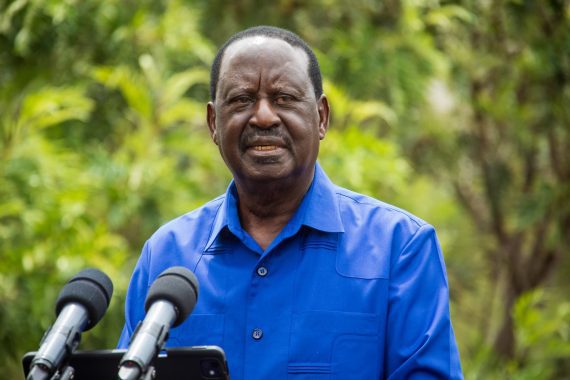ODM leader Raila Odinga has vowed to sue individuals who have issued a notice claiming that the 16-acre parcel of land on which the Kongo Mosque stands is being sold for Ksh1.4 billion.
Speaking after visiting the mosque alongside his lawyer, Paul Mwangi, on Sunday, April 20, 2025, Raila emphasised that the mosque had been issued a title deed long ago during his tenure as a prime minister and insisted that he would not relent in his efforts to prevent the land from being illegally acquired.
“And I will ensure that we go to court next week because of this matter. The lawyer has already gone to court. What they have done is extremely vile and corrupt. But such evils are nothing new to you here,” he said.
Raila further revealed that the case would also involve the Ethics and Anti-Corruption Commission (EACC) and criticised the courts that had issued the notice allowing the land to be listed for sale at the aforementioned amount.
According to him, the individuals behind the notice had used backdoor tactics to obtain it and had proceeded to publish the announcement of the land’s sale, even though the mosque and the local community were the rightful owners of the parcel.
“We have brought forward those responsible for this land grabbing, and we have also involved the EACC, because this is corruption right within the judiciary. The courts are the ones who have enabled this nonsense—someone approaches a judge and receives a ruling without due process,” he stated.

During the meeting, Raila also engaged with other Islamic leaders from the county, reiterating his confidence that they would emerge victorious in court, thereby enabling the community to continue benefiting from the land.
On the same note, he insisted that the mosque was already gazetted as a national heritage site, stating that it had stood for centuries and was even older than Fort Jesus in Mombasa.
He further shared that once the legal battle was concluded, plans should be put in place to subdivide the land so that one portion would be placed under the trusteeship of Kwale County and the National Islamic Centre, while another would be held in trust by the Kongo Mosque. He asserted that this was one of the few effective ways to protect the land from future land grabbing attempts.
“This mosque should be declared a heritage site, and once this case is resolved, the land should be split between two trustees: one for the Islamic Centre and the other for the mosque itself, in order to prevent such incidents in the future. The Kwale International Conference and Holiday Resort will be established here—a centre that can host conferences and also serve as a holiday resort. Visitors will come here, pay to use the facilities, and all proceeds will benefit the community,” he said.
Woman rep’s position
During the meeting, Kwale Woman Representative Fatuma Masito, who had accompanied Raila, also expressed her outrage over the attempted land grab.
She questioned how the perpetrators could go so far as to target a sacred site without remorse.
Fatuma, speaking with visible bitterness, asserted that it was abundantly clear the land belonged to the mosque and the local community and insisted that they would not stand by and watch as the property was unlawfully taken.
“The piece of land in question is a holy place. But now, someone has emerged and is claiming ownership, saying it is already up for sale,” she said.
Historical significance
The Kongo Mosque, situated at the confluence of the Kongo River and the Indian Ocean in Diani, Kwale County, is considered one of the oldest mosques in East Africa, believed to have been constructed in the 14th century by Persian traders.
Originally known as the Diani Persian Mosque, it was rediscovered approximately 300 years ago by Sheikh Mwinyi Kombo, who, following a revelatory dream, located the mosque, which had become overgrown and inhabited by wildlife. He led efforts to rehabilitate the structure, which was subsequently renamed Kongo Mosque in honour of Swaddiq Kongo, a Muslim faithful believed to be buried on the site.
In 1983, the mosque was gazetted as a national monument by the National Museums of Kenya, recognising its historical and cultural significance.
The mosque’s architecture, featuring coral stone walls and surrounded by ancient baobab trees, reflects its rich heritage. It continues to serve as a place of worship, accommodating up to 500 faithful during regular prayers, with numbers swelling to around 5,000 during significant Islamic holidays, where worshippers often extend onto the adjacent beach.